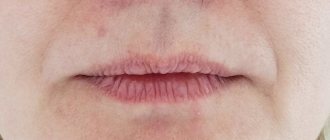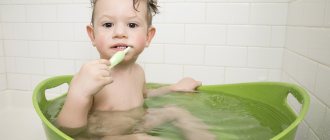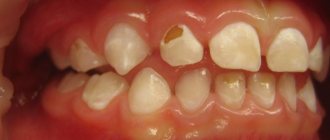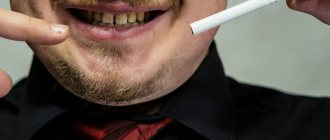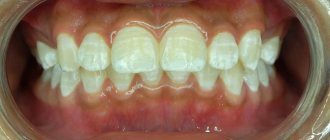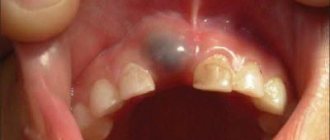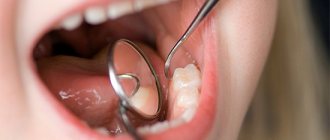Chromogenic components (food, drinks, other products)
The food we eat and other substances we use contain coloring agents (coffee, tea, cola, wine, tobacco, etc.) that can cause yellow, brown or bright orange spots to appear on the skin. teeth In most cases, the discoloration of teeth is generalized, which means that stains tend to form with equal success both on the entire surface of the tooth and in individual areas. If stains appear, it is better to make an appointment with an inexpensive dentist near your place of residence.
Tooth pigmentation - symptoms and treatment
A doctor can make a diagnosis of “teeth pigmentation” by collecting all the necessary data after a survey and examination. If necessary, additional studies are performed.
In modern medicine, there are not many methods for diagnosing tooth pigmentation, so choosing the right one is not difficult. These include:
- visual inspection of clinical manifestations;
- radiography - allows you to evaluate the internal structure of the tooth and identify deviations;
- computed tomography (CT) is a fairly modern research method that is beneficial for both the doctor and the patient (the doctor receives a higher quality image, and the patient receives approximately 90% less radiation); allows you to study the image in 3D format and monitor the dynamics of treatment;
- microscopy - magnifies the area under consideration approximately 25 times, makes it possible to study the structure of the enamel and the extent of the lesion;
- rheodentography - allows you to determine the functional abilities of the pulp, as well as assess the depth of the lesion;
- electroodontodiagnosis is a method of studying the condition of the pulp and periodontium (soft tissues surrounding the root of the tooth) using a dosed electric current that affects the nerve without damaging the tissue membrane of the pulp [8][9].
As a rule, to diagnose ordinary pigmentation, it is enough only to collect complaints, an anamnesis (history of the disease) and a visual examination. Doctors resort to more serious studies, such as CT scanning and a microscope, in case of deeper lesions of the dental cavity and periodontium.
To choose the right treatment method, it is very important to establish a correct diagnosis and not confuse a pigment spot with caries. The latter, unlike dark pigmentation, has a cavity bottom that is not only dark, but also loose.
Superficial caries must also be differentiated from a whole group of non-carious tooth lesions, such as enamel hypoplasia, fluorosis, wedge-shaped defect, erosion and necrosis of hard dental tissues.
With caries, the spot is most often a single one. It is localized in the grooves on the chewing surface or one of the contact surfaces (between the teeth), less often on the neck of the tooth. With hypoplasia and fluorosis, the spots are multiple and localized in places atypical for caries: areas of the labial (cheek) and lingual surface of the tooth crowns.
Spots with hypoplasia are usually white with clear boundaries and have a smooth and shiny surface. They are located at the same level of the crowns of several symmetrically located teeth.
Tooth decay
In the early stages of tooth decay, white spots or spots appear on the tooth enamel. The affected areas lose their natural shine and become dull. A thorough examination reveals the presence of damage to the enamel. If the process of tooth decay progresses, the affected area becomes brown or black, it is necessary to diagnose dental treatment. The damage is initially noticeable as a small dark spot or spots that gradually increase in size (over several months to several years) and often lead to actual tooth decay.
Causes of enamel hypoplasia
| Stains on a child’s permanent teeth provoke: | Stains on primary teeth occur due to: |
|
|
Stains on teeth in children
Young children have many body characteristics that are not characteristic of adults. Some people have poor absorption of some important substances. This also leads to negative consequences. Often, problems with tooth color are caused by pathogenic bacteria. These harmful microorganisms can affect not only the oral cavity, but also the child’s intestines. Fungal infections cause similar disorders.
If a child is prescribed medications containing large doses of iron, this also leads to tooth pigmentation.
Treatment of chalky stains on teeth
Modern methods of treating white spots on enamel can stop the progression of the disease. The method of treatment depends on the factors that caused the disease.
1. If stains appear as a result of leaching of minerals, then tooth enamel is remineralized, which increases its resistance to various diseases. With this method of treatment, special pastes are applied to the teeth, which gradually build up a layer of minerals on the enamel and its destruction stops.
2. When fluorosis is diagnosed, teeth are treated with electrophoresis or application. Special dental trays are made for the patient, which are filled with medications and placed on the teeth.
Causes of yellow spots
Every person dreams of a healthy, snow-white smile. If yellow spots appear on the teeth, this is often a sign of the development of an inflammatory process in the oral cavity, which can be caused by various provoking factors. However, defects do not always appear due to improper dental care. Depending on hereditary factors, people may retain one or another shade of tooth enamel from birth. It's as individual as skin color. To make sure that yellow teeth are a feature of the body and not a disease, it is better to consult a dentist.
The most common causes of yellow spots on teeth include:
- bad habit (smoking). Daily smoking promotes deep penetration of harmful resins and impurities contained in cigarettes into tooth enamel. Since the main vapors contained in smoke primarily touch the front incisors, in smokers they turn yellow or brown before the rest. Next, there is a gradual coverage of the fangs and the rest of the dentition;
- frequent consumption of black tea. Depending on the variety and quality, the substances contained in the drink settle on the teeth to varying degrees, gradually eating into the enamel. Brushing your teeth after each tea party can reduce the risk of staining your teeth;
- increase in dental plaque, formation of stones. If the natural color of the enamel is creamy, the plaque that forms during the day is less noticeable. However, regardless of the natural pigment, a carefully selected toothbrush and toothpaste, proper, timely brushing of teeth can reduce the risk of yellow spots forming on the teeth;
- drinking wine and other alcoholic beverages. In addition to special flavoring ingredients, any of them contains dyes. They can be either natural or synthetic. In any case, they settle on the teeth, so they are difficult to remove with a regular toothbrush. Most likely, periodic dental treatment may be required in a dental clinic.
In addition to the reasons associated with the consumption of certain foods, drinks, and oral hygiene, there are other factors that can trigger the formation of yellow spots on the teeth:
- consequences of dental nerve removal;
- taking certain medications;
- acute or chronic systemic diseases;
- age-related changes;
- clouding of the filling material;
- unbalanced fluoride content in tooth enamel;
- temperature changes;
- lack of vitamins, minerals;
- heredity;
- recent jaundice;
- work in hazardous production.
Also, the cause of yellow teeth may be a disruption of the endocrine system or other pathologies of internal organs.
Professional fighting methods
Modern dentistry has many very effective methods to combat yellowing of enamel. But the most important thing to remember is quality diagnostics. It is necessary that the doctor has all the necessary tools and equipment to determine what caused the spots to appear. Some clinics simply send the patient for whitening instead.
Professional cleaning twice a year is a beneficial procedure for everyone. But if the cause of the yellow color is not plaque, it is important to find out as quickly as possible. Yellowing caused by plaque can be eliminated using several hygienic cleaning methods.
- Laser
. It copes well with plaque and stone, breaking them down into dust due to the destruction of the water molecules contained in this layer. - Ultrasound
. Oscillations of a certain frequency lead to the destruction of layers on the enamel. - Gel and activator lamp
. The product based on hydrogen peroxide is activated by a special photo lamp.
If pigmentation occurs due to cleaning of the canals and removal of nerves, then special agents are used that are injected into the dental canal and the cavity where the pulp was previously located. The substance acts on the tooth from the inside.
This article comes to its logical conclusion. I'm waiting for your comments. Share your personal experience. Subscribe to site news! Dentures for one tooth you will find the answer in the link.
Rules for children's dental hygiene
The first oral hygiene procedures begin after the baby has cut his first tooth. During this period, the brush is not yet used, and the gums are wiped with a damp cloth. When several teeth erupt, you can begin hygiene with the help of a special baby brush. It should be very soft and delicately clean the delicate surface of children's teeth. When a child reaches 2.5 years of age, he is taught to practice brushing independently, at first without toothpaste. When the baby masters this procedure, you can use special baby pastes, which are designed for the fact that the baby has not yet learned to spit out the paste and will periodically swallow it. Children's pastes should be free of dyes, flavorings and fragrances.
